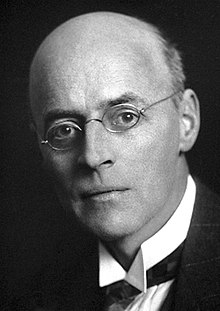Owen Willans Richardson
Sir Owen Richardson | |
|---|---|
 Richardson in 1928 | |
| Born | Owen Willans Richardson 26 April 1879 Dewsbury, Yorkshire, UK |
| Died | 15 February 1959 (aged 79) Alton, Hampshire, England |
| Nationality | British |
| Education | Batley Grammar School |
| Alma mater | |
| Known for | Richardson's law Einstein–de Haas effect |
| Awards |
|
| Scientific career | |
| Fields | Physics |
| Institutions | |
| Doctoral advisor | J. J. Thomson[2] |
| Doctoral students | |
| Signature | |
Sir Owen Willans Richardson,
Biography
Richardson was born in Dewsbury, Yorkshire, England, the son of Joshua Henry and Charlotte Maria Richardson. He was educated at Batley Grammar School and Trinity College, Cambridge, where he gained First Class Honours in Natural Sciences.[9] He then got a DSc from University College London in 1904.[9]
After graduating in 1900, he began researching the emission of electricity from hot bodies at the Cavendish Laboratory in Cambridge, and in October 1902 he was made a fellow at Trinity.[10] In 1901, he demonstrated that the current from a heated wire seemed to depend exponentially on the temperature of the wire with a mathematical form similar to the Arrhenius equation. This became known as Richardson's law: "If then the negative radiation is due to the corpuscles coming out of the metal, the saturation current s should obey the law ."[11]
Richardson was professor at Princeton University from 1906 to 1913, and returned to the UK in 1914 to become Wheatstone Professor of Physics at King's College London, where he was later made director of research in 1924.[12] In 1927, he was one of the participants of the fifth Solvay Conference on Physics that took place at the International Solvay Institute for Physics in Belgium. He retired from King’s College London in 1944, and died in 1959. He is buried in Brookwood Cemetery in Surrey.
He also researched the
Richardson married Lilian Wilson, sister of his Cavendish colleague Harold Wilson, in 1906, and had two sons and a daughter. Richardson had two sisters. Elizabeth Mary Dixon Richardson married the prominent mathematician Oswald Veblen. Charlotte Sara Richardson married the American physicist (and 1937 Nobel laureate) Clinton Davisson, who was Richardson's PhD student at Princeton. After Lilian's death in 1945, he was remarried in 1948 to Henriette Rupp, a physicist.
Owen Willans Richardson had a son, Harold Owen Richardson, who specialised in Nuclear Physics and was also the chairman of the Physics Department at Bedford College, London University and later on became emeritus professor at London University.[citation needed]
Honours

Richardson was elected an International Member of the
Works
-
Title page to The emission of electricity from hot bodies (1916)
-
Preface to The emission of electricity from hot bodies (1916)
-
Table of contents to The emission of electricity from hot bodies (1916)
-
First page to The emission of electricity from hot bodies (1916)
References
- ^ S2CID 71230816.
- .
- ^ "Owen Willans Richardson: The Nobel Prize in Physics 1928". Nobel Lectures, Physics 1922-1941, Elsevier Publishing Company, Amsterdam. Nobel Foundation. 1965. Retrieved 18 October 2022.
- S2CID 4073897
- PMID 17830216
- S2CID 39108526
- PMID 17792421
- ^ Owen Richardson's Nobel lecture on thermionics, 12 December 1929
- ^ a b "Richardson, Owen Willans (RCRT897OW)". A Cambridge Alumni Database. University of Cambridge.
- ^ "University intelligence". The Times. No. 36893. London. 8 October 1902. p. 4.
- ^ O. W. Richardson (1901) "On the negative radiation from hot platinum," Philosophical of the Cambridge Philosophical Society, 11 : 286–295; see especially p. 287.
- ^ "Sir Owen Willans Richardson | Nobel Prize, Thermionic Emission, Heat Transfer | Britannica". www.britannica.com. Retrieved 20 October 2023.
- ^ "APS Member History". search.amphilsoc.org. Retrieved 7 December 2023.
- ^ Nobel prize citation, Nobel foundation website
External links
 Media related to Owen Willans Richardson at Wikimedia Commons
Media related to Owen Willans Richardson at Wikimedia Commons- Owen Willans Richardson on Nobelprize.org





